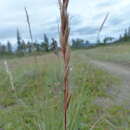Comprehensive Description
provided by North American Flora
Avena hookeri Scribn. in Hack. True Grasses 123. 1890
Avena pralensis var. americana Scribn. Bot. Gaz. 11: 177. 1886. {Based on A. versicolor as described by Hooker, Fl. Bor. Am. 2: 244. 1840. Rocky Mountains, Driimmond [209]. Not A. versicolor Vill. 1779).
Avena americana .Scribn. Bull. U. S. Dep. Agr. Agrost. 7: 183. 1897. (Based on A. pralensis var. americana Scribn.)
Perennial; culms densely tufted, leafy toward the base, erect, 20-40 cm. tall; sheaths overlapping, keeled; ligule about 3 mm. long; blades firm, flat or folded, with a thick white nerve on the margin, 2-3 mm. wide, the lower as much as 15-20 cm. long; panicle long-exserted, narrow, 5-10 cm. long, the branches erect or nearly so, bearing a single spikelet, or the lower 2; spikelets erect, about 1.5 cm. long; glumes very thin, subequal, 3-nerved; florets 3-6, exceeding the glumes, the rachilla densely white-bearded; lemmas firm, brown, scaberulous, 1-1.2 cm. long, the callus short-bearded, the apex erose, the awn attached a little above the middle, twisted below, geniculate, 1-1.5 cm. long.
Typb locality: Rocky Mountains (Drummond) .
Distribution: Dry slopes and prairies, Manitoba and North Dakota to Alberta, Montana, and New Mexico.
- bibliographic citation
- Albert Spear Hitchcock, Jason Richard Swallen, Agnes Chase. 1939. (POALES); POACEAE (pars). North American flora. vol 17(8). New York Botanical Garden, New York, NY
Physical Description
provided by USDA PLANTS text
Perennials, Terrestrial, not aquatic, Stems nodes swollen or brittle, Stems erect or ascending, Stems caespitose, tufted, or clustered, Stems terete, round in cross section, or polygonal, Stem internodes hollow, Stems with inflorescence less than 1 m tall, Stems, culms, or scapes exceeding basal leaves, Leaves mostly basal, below middle of stem, Leaves mostly cauline, Leaves conspicuously 2-ranked, distichous, Leaves sheathing at base, Leaf sheath mostly open, or loose, Leaf sheath smooth, glabrous, Leaf sheath and blade differentiated, Leaf blades linear, Leaf blades 2-10 mm wide, Leaf blades mostly flat, Leaf blade margins folded, involute, or conduplicate, Leaf blades mostly glabrous, Ligule present, Ligule an unfringed eciliate membrane, Inflorescence terminal, Inflorescence a contracted panicle, narrowly paniculate, branches appressed or ascending, Inflorescence solitary, with 1 spike, fascicle, glomerule, head, or cluster per stem or culm, Inflorescence with 2-10 branches, Inflorescence branches more than 10 to numerous, Flowers bisexual, Spikelets pedicellate, Spikelets laterally compressed, Spikelet less than 3 mm wi de, Spikelets with 3-7 florets, Spikelets solitary at rachis nodes, Spikelets all alike and fertille, Spikelets bisexual, Spikelets disarticulating beneath or between the florets, Rachilla or pedicel hairy, Glumes present, empty bracts, Glumes 2 clearly present, Glumes equal or subequal, Glumes equal to or longer than adjacent lemma, Glumes 3 nerved, Glumes 4-7 nerved, Lemmas thin, chartaceous, hyaline, cartilaginous, or membranous, Lemma similar in texture to glumes, Lemma 5-7 nerved, Lemma glabrous, Lemma rugose, with cross wrinkles, or roughened, Lemma apex dentate, 2-fid, Lemma distinctly awned, more than 2-3 mm, Lemma with 1 awn, Lemma awn 1-2 cm long, Lemma awn subapical or dorsal, Lemma awn twisted, spirally coiled at base, like a corkscrew, Lemma awn once geniculate, bent once, Lemma margins thin, lying flat, Lemma straight, Callus or base of lemma evidently hairy, Callus hairs shorter than lemma, Palea present, well developed, Palea membranous, hyaline, Palea about equal to lemma, Stamens 3, Styles 2-fid, deeply 2-branched, Stigmas 2, Fruit - caryopsis, Caryopsis hairy at apex.

